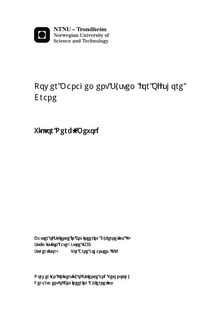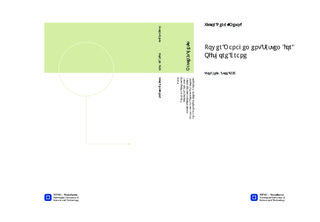| dc.description.abstract | The main objective in this thesis is to control the power consumption of a lattice boom offshore crane in order to reduce frequency variations and prevent blackouts. After studying how the electrically powered offshore lattice boom cranes works and are put together, a dynamic model of the power consumption for a crane was developed. By using the moment balance for the different systems on the crane (hoisting, luffing and slewing) the torque needed to drive the system at a given speed is calculated. A model of a diesel generator was also implemented. This model was found in an technical article, and implemented mainly by using parameters for a 440kW diesel generator. Some of the parameters had to be found in other literature. These values are "typical values" for diesel generators, and may be the cause of that the modelled diesel generator has a relatively slow response.Two datasets were received from National Oilwell Varco Molde AS(NOV) which shows total load in kW and the corresponding RPM of the diesel generator from an actual crane. The load sequences from these datasets were extracted in order to have realistic load scenarios for simulations.The next step was to set up three different simulation scenarios in order to explore the advantages of feeding the measured load forward to the regulator of the RPM of the diesel generator. The first scenario was made by using the model of the crane with a sequence of different reference speeds for the speed controllers for the three systems on the crane. The two other scenarios are using the load sequences from the two datasets received from NOV. After running these three simulation scenarios both with and without the feed forward and studying how this influenced the RPM of the diesel generator, the conclusion was that it reduced the variations of the RPM. The small variations were almost completely removed, while large variations in the load still caused peaks in the RPM even though they were reduced.The large peaks still remained because of that the diesel generator has a limit to how fast it can increase its produced power. When the total load consumed by the crane has a large instant increase, the diesel generator does not manage to follow and in worst case, it blacks out.Therefore this had to be prevented by limiting the rate of change of the load, so that it does not increase faster than that the diesel generator manages to increase its produced power. In this project a MATLAB function is used to limit the requested load from the different speed controllers for the three systems on the crane. In addition to the rate of change, it also has to control that the total consumed load does not exceed the maximum load that the generator is able to produce. When sharing the power between the different systems, the hoisting system has a 100\% priority, while the luffing and the slewing system shares the remaining power available based on how many percent of their maximum power consumed they requests. The effect of this limitation is shown by running a simulation by using the first simulation scenario. The reason for choosing the load sequence that is generated by running the crane model is that the loads for the different systems are available separately, whereas in the datasets received from NOV only the combined total load is available. The conclusion is that the combination of the feed forward and the limitation of the requested load and the rate of change of the requested load, helps reduce the variations in the RPM of the diesel generator significantly. Thereby the variations in the frequency are reduced and an eventual power blackout is prevented. | nb_NO |

